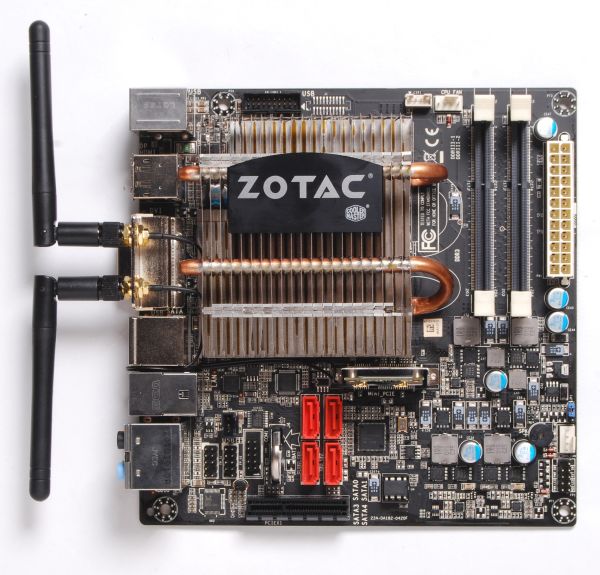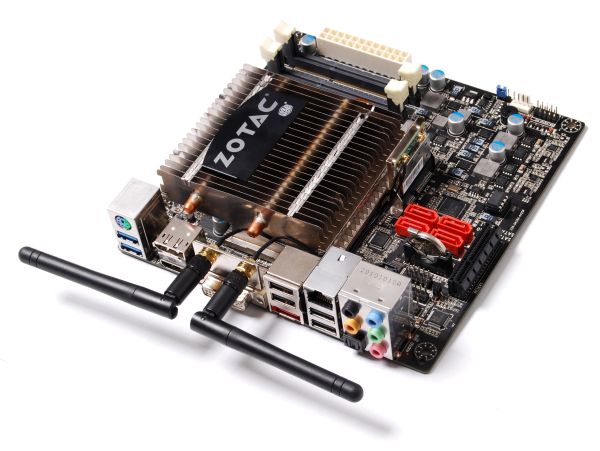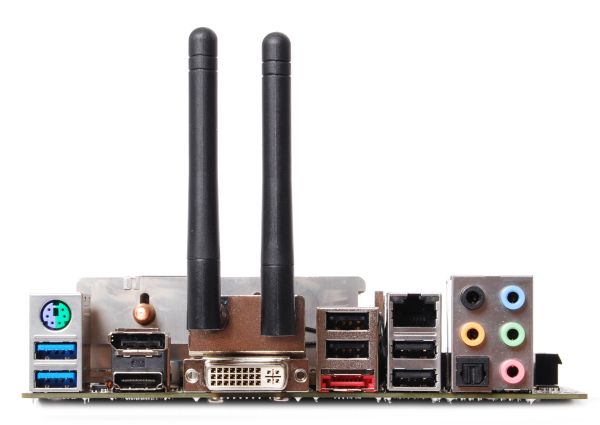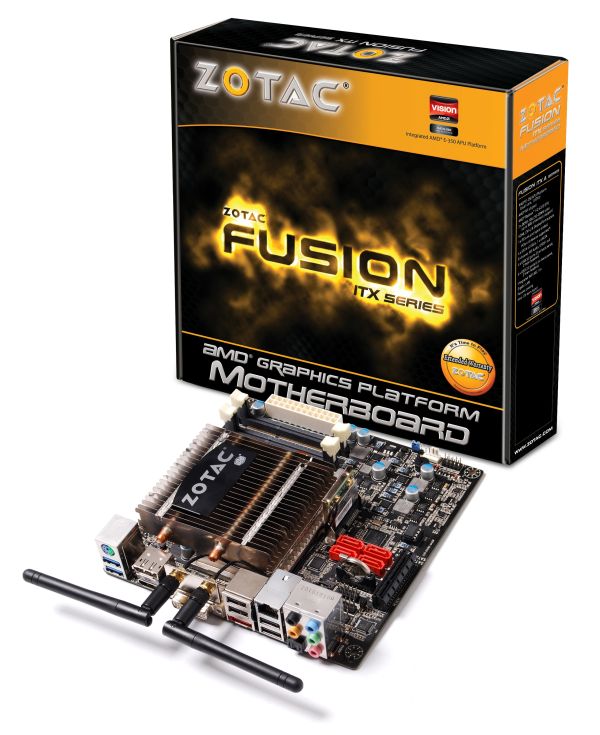Fusion E-350 Review: ASUS E35M1-I Deluxe, ECS HDC-I and Zotac FUSION350-A-E
by Ian Cutress on July 14, 2011 11:00 AM ESTOn the outside, this Zotac Fusion board mimics the view I see in almost all of Zotac's product range - mini-ITX, jam-packed full of features, and for a little price premium. Some of this is true - the FUSION350-A-E has a Cooler Master designed passive cooler, SO-DIMM memory to improve space on the board, and a Wifi card with a pair of antenna. For the most part, however, I've found this board has underperformed. In terms of performance, it's nothing spectacular (or worse than the rest at times), and doesn't offer anything significantly different. It needs a fresh injection of BIOS and software, as well as more robust controllers to become a more desirable product.
Visual Inspection
On the front of it, looking at the Zotac board and seeing such a small cooler compared to the ASUS board can be a bit puzzling. On show are the obvious copper heatpipes, and a Cooler Master logo, showing the joining of the two companies to produce the passive heatsink. Along the top sports a USB 3.0 header, a CPU fan header (a chipset requirement, even if it is a passive solution), and the two SO-DIMM memory slots.
Along the right hand side is the 24-pin power connector, the clear CMOS jumper, a 4-pin system fan header and the front panel connectors. Nothing too out of the ordinary here, though there is space to put the SATA connectors here rather than above the open ended PCIe x4 slot.
The open ended PCIe x4 slot is essentially what a PCIe x16 slot is when it is in x4 mode. So there is scope to add some GPUs here. Above this are the four SATA 6 Gbps connectors and the mini-PCIe wifi card, which is hooked into the antenna holders on the I/O panel automatically. The board also sports a COM header, a USB 2.0 header, a SPDIF out header, and the front panel audio header, all in the corner around the PCIe x4 and the I/O panel.
Nothing too different on the I/O panel compared to other models, except the USB 3.0 ports powered by a VIA controller are directly below a legacy PS2 port. This motherboard supports HDMI, DisplayPort and DVI from the onboard connectors (VGA requires a converter). Alongside four USB 2.0 ports is the eSATA 3 Gbps, a gigabit Ethernet port, 8-channel HD audio and an optical SPDIF output.














67 Comments
View All Comments
sprockkets - Thursday, July 14, 2011 - link
I have the AsRock board. I get 18w idle and 24w under load via a killawatt device. Granted it uses an 80w power supply, but I'm kinda wondering how you got 59w for something that is practically the same setup in each board.IanCutress - Thursday, July 14, 2011 - link
I was using a less than ideal power supply for the power draw tests which was very inefficient in this range (<20% of maximum power), and unfortunately I don't have anything more appropriate at hand to test with. The comparisons (I believe) between the boards are more than relevant though. I will hopefully rectify this in future reviews of lower powered systems.Ian
formulav8 - Thursday, July 14, 2011 - link
Why didn't you wait to do power consumption tests then?bah12 - Thursday, July 14, 2011 - link
While not ideal, I'd say the whole point of this article was to illustrate the differences in the boards. Thus as long as they all suffered from the same inefficient PS, the information is not useless in that you can still draw a conclusion based on the differences at the board level. All and all, not ideal but useful.BushLin - Friday, July 15, 2011 - link
I once tried to reason with the fanboys at AMDZone on Anands behalf, defending that the reviews here were objective... I think I'm starting to believe that their might be some truth in their beliefs that the odds are stacked against AMD when their products are reviewed on here.At best, this review is a misguided. It focuses far too heavily on areas these systems are not aimed at, misinforms (or fails to inform) on areas that it's market are interested in and answers stupid questions that no-one is asking. Testing a GTX 580 with an E-350 at 4x PCI-E... really? Why not test out how well these work as a HTPC compared to something like ION and the latest Atom?
At worst, this review could almost be seen as a deliberate undermining of a technology that's potentially superior to it's Intel's offering and how often could you honestly say that since Core2?. Most of the tests are irrelevant (or become irrelevant when comparing to much higher TDP chips), the one test you did manage to do which is very relevant (power consumption) was so high that it prompted me to look at other reviews and take the time to write this comment!
This review has idle power consumption as at least 36w, Xbit have it at 7.3w even with a 880w PSU. One of these reviews has it very wrong, I know which one I'm more inclined to believe.
http://www.xbitlabs.com/articles/cpu/display/amd-e...
IKeelU - Friday, July 15, 2011 - link
I have to agree with your assessment of the review.- These boards are aimed at HTPC market, but the review was focused...elsewhere (frankly, I can't tell what the focus was).
- How is the audio quality? I was very interested in the ASUS board until I noticed it doesn't have 6-channel direct out. This is important!
- Another, less important, point: The features/specs for each board should come first. Double points for a feature comparison table.
AnandThenMan - Friday, July 15, 2011 - link
It is extremely unfortunate that Anandtech has sacrificed their integrity when it comes to reviewing some of AMD's products. I really hope that more and more people are made aware of what is going on, these reviews are downright dishonest.The most important question people need to ask is, why is this happening? What is the incentive for Anandtech.com to publish these misleading reviews?
ET - Saturday, July 16, 2011 - link
Can you explain what is dishonest or misleading about this review? I agree that it could be better, but I don't see anything to indicate that anything was falsified here.medi01 - Sunday, July 17, 2011 - link
Seriously?Cough "This review has idle power consumption as at least 36w, Xbit have it at 7.3w even with a 880w PSU. ", cough?
Oh, it's irrelevant, because we're comparing motherboards of the same platform? Orly? What if I read this, say "OMG it consumes so much energy" and go buy Atom?
Tell me how to get that 36w idle thing, what kind of PSU should be used, to justify 7.3w (with bloody 880w PSU!!!!) vs 36w please?
What are 5850 580gtx doing in this review?
Shameless...
Finraziel - Thursday, September 1, 2011 - link
Monstrously late reply... but I just can't not leave this comment... Did any of you actually read the xbit article? Those power draw measurements are measured between the PSU and the components, only measuring what the components are actually using, completely ignoring the efficiency of the PSU (the way xbitlabs has been testing for years I might add). So the fact that they were using an 880W PSU has absolutely zero bearing on their readings.Granted, it's still a shame that these boards couldn't have been tested with something like a pico psu, and I do agree the article could have been better (for instance, how much noise does that tiny fan on the ECS board actually make? apart from an easily missed remark in the conclusion nothing is said about it), but it's not as bad as you people are making it out to be.